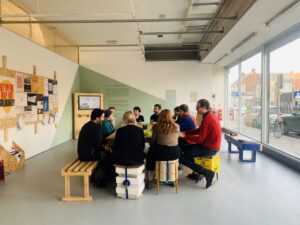Reflection of the class
In this weekly session, I consider the discourse around curation and public programmes by examining a number of cases. Through various examples of public programmes, I examine questions of curatorial responsibility, strategy, related challenges, innovation and responsiveness.
To begin with, public programmes often act as broad-based educational practices within the curatorial framework of contemporary art, which Wilson & O’neill (2010) describes as an educational turn, a move towards the penetration of education as a device of social production and reproduction into broader cultural practices. This means that there is a movement whereby systems and programmes related to education are included within contemporary art and its associated critical framework.
Curation is moving from the development and evolution of exhibitions to functioning as a pluralistic discourse, extending contemporary art practice into local and everyday aspects of people’s lives. The provision of arts experiences for children and young people outside of schooling cannot compensate for the pressures and impoverishment of arts education in schools, but over the past two decades there has been an expansion of practices and ideas about learning in galleries (Pringle 2011). Evidence of an educational turn in arts practice can be found in the participatory educational programme ‘World Without Walls’ at the Serpentine Gallery in London. The programme professes to implement art practices for social action and change and actively engages with the public (Franks, 2020). His research argues that the project is community-based in Serpentine and centred on education and learning to bring about social and political change through participation in artistic practice. As a contemporary art institution, it is creating social change by creating opportunities to raise and discuss community issues to a shared local audience. Moreover, it provides an opportunity to use the educational process and for citizens to independently and proactively acquire certain knowledge through their observations and practices.
Another example is the New Bridge project, a case study assigned in-class: the NewBridge project is a public programme that responds to the diverse needs and interests of the community and adopts a participatory approach (The New Bridge Project, n.d.). Examples include community art projects and workshops, public discussions and panels, public art installations, community events and festivals. These programmes involve local artists and creators, deepen links with the local community and contribute to promoting sustainable social change and strengthening local identity. Both examples show that by creating opportunities to raise and discuss community issues to local people in the context of contemporary art, they are creating social change. Moreover, they use the process of education to provide opportunities for citizens to independently and proactively acquire certain knowledge through their observations and practices.

The New Bridge Project (n.d.). Available at https://thenewbridgeproject.com/about/about-us/
My Curatorial Project
Having described this public project as a broad-based artistic practice that encourages people to address common problems, I would like to discuss how this can work within my project, using the educational programme using street art as an example in W8. Within my curatorial project, I will be conducting a ‘Trail Walk’, which will explore and discuss street art with the public while walking through the streets of Bristol. During the course of the walking tour, the public will hear about the artists behind the murals and how the finished works came to be. Tour guides, including artists, will talk about each artwork on the tour, how they were created and the stories that inspired them. I think it is a participatory programme that is in line with the educational practices of contemporary art discussed in this week’s lecture, as the themes of street art, including local history, current politics and many social issues contained in the works, are opportunities for participants to develop proactive discussions on community issues.
References:
Franks, A. (2020). Expanding the gallery: Curation, pedagogy and social action in community-based arts programmes. In Debates in Art and Design Education (pp. 196-210). Routledge.
Pringle, E. (2011). The gallery as a site for creative learning 1. In The Routledge international handbook of creative learning (pp. 234-243). Routledge.
The New Bridge Project. (n.d.). The Late Shows 2024. Available at https://thelateshows.org.uk/2023/the-newbridge-project-1 (Accessed on April 8, 2024 )
Wilson, M., & O’neill, P. (2010). Curatorial counter-rhetorics and the educational turn. Journal of Visual Art Practice, 9(2), 177-193.

Leave a Reply